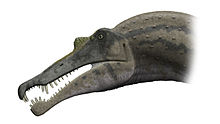

Description
Since its discovery, Spinosaurus has been a contender for the longest and largest theropod dinosaur.[5] Both Friedrich von Huene in 1926[6] and Donald F. Glut in 1982 listed it as among the most massive theropods in their surveys, at 15 meters (49 ft) in length and upwards of 6 t (5.9 long tons; 6.6 short tons) in weight.[7] In 1988, Gregory Paul also listed it as the longest theropod at 15 meters (49 ft), but gave a lower mass estimate of 4 tonnes (3.9 long tons; 4.4 short tons).[8]
Dal Sasso et al. (2005) assumed that Spinosaurus and Suchomimus had the same body proportions in relation to their skull lengths, and thereby calculated that Spinosaurus was 16 to 18 meters (52 to 59 ft) in length and 7 to 9 tonnes (6.9 to 8.9 long tons; 7.7 to 9.9 short tons) in weight.[3] The Dal Sasso et al. estimates were criticized because the skull length estimate was uncertain, and (assuming that body mass increases as the cube of body length) scaling Suchomimus which was 11 meters (36 ft) long and 3.8 tonnes (4.2 short tons) in mass to the range of estimated lengths ofSpinosaurus would produce an estimated body mass of 11.7 to 16.7 tonnes (12.9 to 18.4 short tons).[2]
François Therrien and Donald Henderson, in a 2007 paper using scaling based on skull length, challenged previous estimates of the size of Spinosaurus, finding the length too great and the weight too small.[2] Based on estimated skull lengths of 1.5 to 1.75 meters (4.9 to 5.7 ft), their estimates include a body length of 12.6 to 14.3 meters (41 to 47 ft) and a body mass of 12 to 20.9 tonnes (11.8 to 20.6 long tons; 13.2 to 23.0 short tons).[2] The lower estimates for Spinosaurus would imply that the animal was shorter and lighter than Carcharodontosaurus and Giganotosaurus.[2] The Therrien and Henderson study has been criticized for the choice of theropods used for comparison (e.g., most of the theropods used to set the initial equations were tyrannosaurids and carnosaurs, which have a different build than spinosaurids), and for the assumption that the Spinosaurus skull could be as little as 1.5 meters (4.9 ft) in length.[9][10] Improvement of the precision of size estimates for Spinosaurus requires the discovery of more complete remains as available for some other dinosaurs,[11] especially the limb bones ofSpinosaurus which are "hitherto unknown".[3]
Neural spines
Very tall neural spines growing on the back vertebrae of Spinosaurus formed the basis of what is usually called the animal's "sail". The lengths of the neural spines reached over 10 times the diameters of the vertebral bodies from which they extended.[12] The neural spines were slightly longer front to back at the base than higher up, and were unlike the thin rods seen in the pelycosaur finbacks Edaphosaurusand Dimetrodon, contrasting also with the thicker spines in the iguanodontian Ouranosaurus.[12]
Spinosaurus sails were unusual, although other dinosaurs, namely the ornithopod Ouranosaurus, which lived a few million years earlier in the same general region as Spinosaurus, and the South American sauropodAmargasaurus, might have developed similar structural adaptations of their vertebrae. The sail may be an analog of the sail of the Permian synapsid Dimetrodon, which lived before the dinosaurs even appeared, produced byconvergent evolution.[12]
The structure may also have been more hump-like than sail-like, as noted by Stromer in 1915 ("one might rather think of the existence of a large hump of fat [German: Fettbuckel], to which the [neural spines] gave internal support")[13] and by Jack Bowman Bailey in 1997.[12] In support of his "buffalo-back" hypothesis, Bailey argued that in Spinosaurus, Ouranosaurus, and other dinosaurs with long neural spines, the spines were relatively shorter and thicker than the spines of pelycosaurs (which were known to have sails); instead, the dinosaurs' neural spines were similar to the neural spines of extinct hump-backed mammals such as Megacerops and Bison latifrons.[12]
Skull
The skull had a narrow snout filled with straight conical teeth that lacked serrations. There were six or seven teeth on each side of the very front of the upper jaw, in the premaxillae, and another twelve in both maxillae behind them. The second and third teeth on each side were noticeably larger than the rest of the teeth in the premaxilla, creating a space between them and the large teeth in the anterior maxilla; large teeth in the lower jaw faced this space. The very tip of the snout holding those few large anterior teeth was expanded, and a small crest was present in front of the eyes.[3] Using the dimensions of three specimens known as MSNM V4047, UCPC-2, and BSP 1912 VIII 19, and assuming that the postorbital part of the skull of MSNM V4047 had a shape similar to the postorbital part of the skull of Irritator, Dal Sasso et al. (2005) estimated that the skull of Spinosaurus was 1.75 meters (5.7 ft) long.[3] The Dal Sasso et al. skull length estimate was questioned because skull shapes can vary across spinosaurid species.[2]
A newly made study performed by scientists Andrew R. Cuff and Emily Rayfield showed that Spinosaurids like Spinosaurus had relatively poor resistance in their skulls for torsion compared to other members of this group (Baryonyx) and modern alligators, thus showing Spinosaurus preyed more regularly on fish than it did on land animals, although considered predators of the former too.[14]



No comments:
Post a Comment